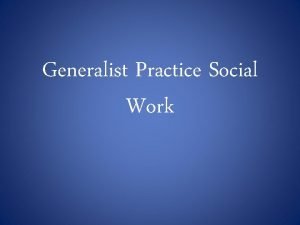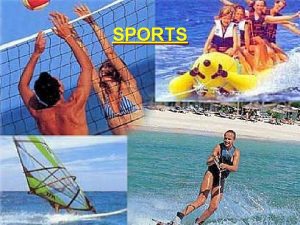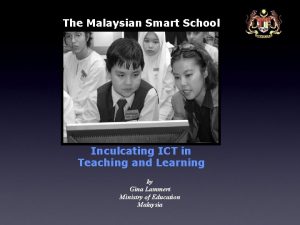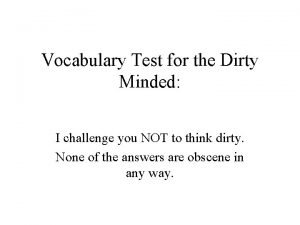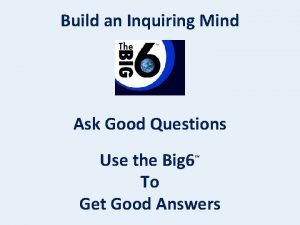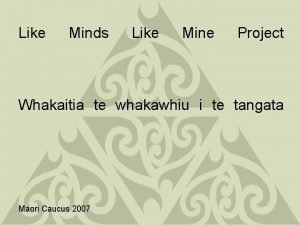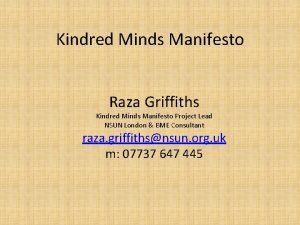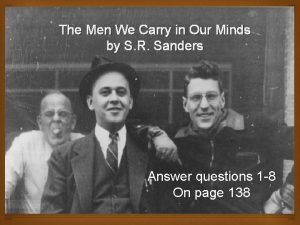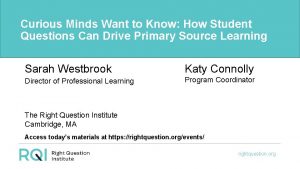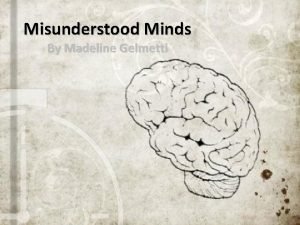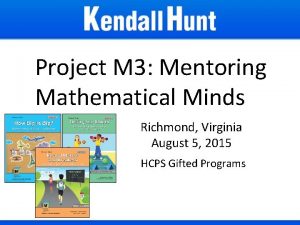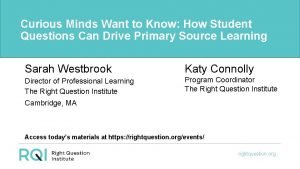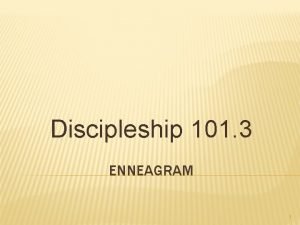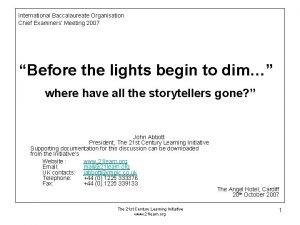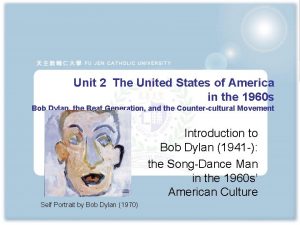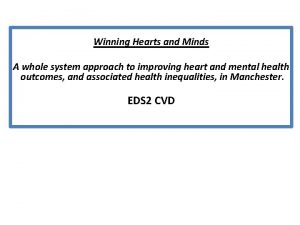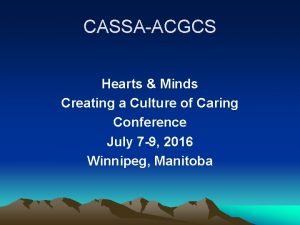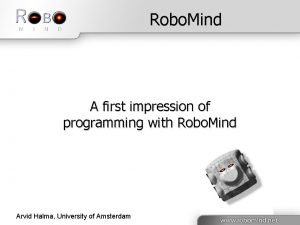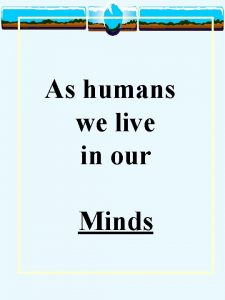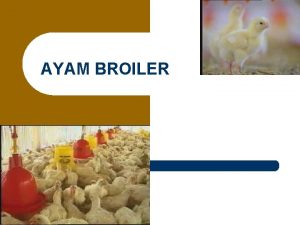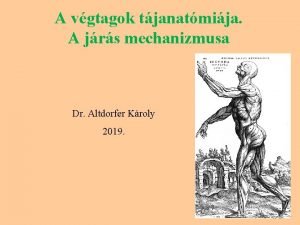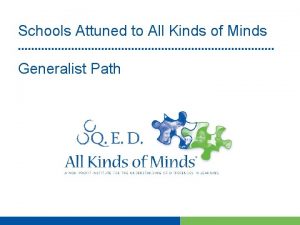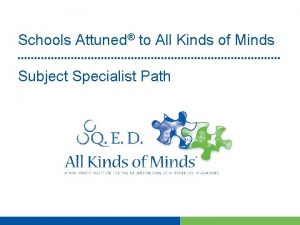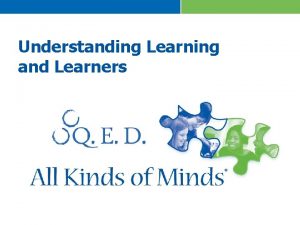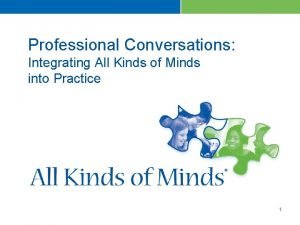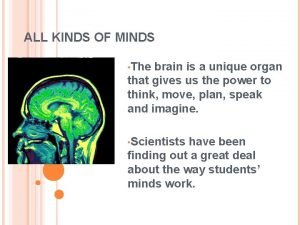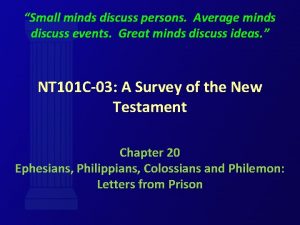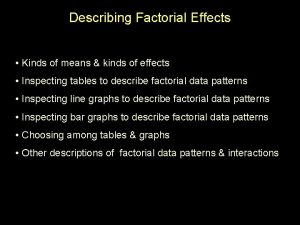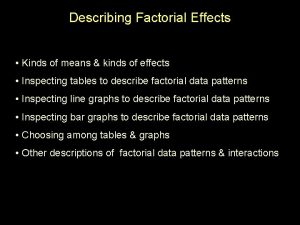Schools Attuned to All Kinds of Minds Generalist
































































- Slides: 64

Schools Attuned to All Kinds of Minds Generalist Path

Directions for Introducing Yourself GP: INT PP 1 > You have only 30 seconds. Choose your words carefully! > Your name > Where you are from > Students you teach or other job description > Brief description of positive or negative learning experience OR > Brief description of yourself as a learner > You will be timed by the person to your right. > At the 25 -second mark, the person on your right will hand you the watch. You will have 5 seconds to wrap up your introduction. > At the 30 -second mark, give a START signal to the person on your left. > At the 25 -second mark, hand the watch to the person on your left. All Kinds of Minds® and Schools Attuned ® are marks of Q. E. D. Foundation. © 2013 Q. E. D. Foundation. All rights reserved. > Your introduction should cover the following points:

Four Compass Points GP: INT PP 2 STRUCTURE Organization of systems, attention to detail CARING Concern to include all people, W maintenance of group cohesiveness ACTION Just do it! Learn E from it and refine the next set of actions. S MEANING Need to know the vision, attention to the big picture All Kinds of Minds® and Schools Attuned ® are marks of Q. E. D. Foundation. © 2013 Q. E. D. Foundation. All rights reserved. N

1. A Positive View of Neurodevelopmental Diversity 2. A Stress on Neurodevelopmental Profiles 3. A Quest for Specificity and Individuality in Understanding Students 4. A Policy of Labeling Observable Phenomena Rather than Children 5. A Commitment to Collaboration Among Professionals, Parents, and Children 6. A Desire to Strengthen the Strengths and Affinities of Children 7. A Belief in the Power of Demystification 8. A Consistent Effort to Help Learners Learn About Learning 9. An Infusion of Optimism for Kids with All Kinds of Minds® and Schools Attuned ® are marks of Q. E. D. Foundation. © 2013 Q. E. D. Foundation. All rights reserved. Schools Attuned: The Premises in Nine Principles GP: INT PP 3

All Kinds of Minds® and Schools Attuned ® are marks of Q. E. D. Foundation. © 2013 Q. E. D. Foundation. All rights reserved. Schools Attuned Conceptual Model GP: INT PP 4

All Kinds of Minds® and Schools Attuned ® are marks of Q. E. D. Foundation. © 2013 Q. E. D. Foundation. All rights reserved. Schools Attuned Conceptual Model – All Kinds of Minds Philosophy GP: INT PP 5

All Kinds of Minds® and Schools Attuned ® are marks of Q. E. D. Foundation. © 2013 Q. E. D. Foundation. All rights reserved. Schools Attuned Conceptual Model – Neurodevelopmental Framework GP: INT PP 6

GP: INT PP-7 ATTENTION (CONSTRUCT) MENTAL ENERGY CONTROLS Alertness Mental Effort Sleep Arousal/Balance Performance Consistency (FUNCTION) PROCESSING CONTROLS Saliency Determination Depth/Detail of Processing Cognitive Activation Focal Maintenance Satisfaction Level (FUNCTION) PRODUCTION CONTROLS Previewing Facilitation/Inhibition Pacing Self-Monitoring Reinforceability (FUNCTION) (Components) All Kinds of Minds® and Schools Attuned ® are marks of Q. E. D. Foundation. © 2013 Q. E. D. Foundation. All rights reserved. Construct Deconstruction

All Kinds of Minds® and Schools Attuned ® are marks of Q. E. D. Foundation. © 2013 Q. E. D. Foundation. All rights reserved. Sample Participant Objectives Page GP: INT PP 8

All Kinds of Minds® and Schools Attuned ® are marks of Q. E. D. Foundation. © 2013 Q. E. D. Foundation. All rights reserved. Schools Attuned Conceptual Model – Processes and Tools GP: INT PP-9

All Kinds of Minds® and Schools Attuned ® are marks of Q. E. D. Foundation. © 2013 Q. E. D. Foundation. All rights reserved. Schools Attuned Conceptual Model – School Level GP: INT PP-10

All Kinds of Minds® and Schools Attuned ® are marks of Q. E. D. Foundation. © 2013 Q. E. D. Foundation. All rights reserved. Schools Attuned Conceptual Model – Classroom Level GP: INT PP-11

All Kinds of Minds® and Schools Attuned ® are marks of Q. E. D. Foundation. © 2013 Q. E. D. Foundation. All rights reserved. Schools Attuned Conceptual Model – Student Level GP: INT PP-12

All Kinds of Minds® and Schools Attuned ® are marks of Q. E. D. Foundation. © 2013 Q. E. D. Foundation. All rights reserved. GP: INT PP-13 Schools Attuned Conceptual Model

All Kinds of Minds® and Schools Attuned ® are marks of Q. E. D. Foundation. © 2013 Q. E. D. Foundation. All rights reserved. Phases of Implementation GP: INT PP-14

GP: MEM PP-1 DIGEST HAWKING LAUNCH COMMUNITY FROCK PURSUIT VANDALISM

Memory Case Studies Activity Advance Organizer PART 1 JIGSAW: EXPERT GROUPS (50 minutes) 1. Break into four expert groups: Margaret, Martin, Mariko, Mujim 2. As individuals (5 minutes): > Read the instructions for the activity > Read your student’s narrative 3. As a group (25 minutes): > Identify your student’s strengths > Identify your student’s weaknesses > Brainstorm management strategies 4. Break into pairs (20 minutes): > Design a specific management strategy to help your student > Plan a case study presentation PART 2 JIGSAW: INTER-AGED GROUPS (40 minutes) Each member has 10 minutes to present his/her case study PART 3: DEBRIEF (15 minutes) Assemble as a core group to debrief the activity GP: MEM PP-2

GP: TSN PP-1 PART I: Expert Groups on Spatial Ordering, Temporal. Sequential Ordering, and Neuromotor Functions (45 minutes) 1. Read and discuss Construct Elaboration pages for your Construct 2. Complete Construct Guide for your Construct Participants at Temporal. Sequential Ordering tables: > Construct Elaboration pages TSN-37 -41 > Construct Guide page TSN-18 Participants at Spatial Ordering tables: > Construct Elaboration pages TSN-38, TSN-41 -44 > Construct Guide page TSN-19 Participants at Neuromotor Functions tables: > Construct Elaboration pages TSN-46 -54 > Construct Guide page TSN-20 (continued on next slide) All Kinds of Minds® and Schools Attuned ® are marks of All Kinds of Minds. © 2008 All Kinds of Minds. All rights reserved. Three Construct Jigsaw Activity Advance Organizer I

GP: TSN PP-1 (cont’d) Three Construct Jigsaw Activity Advance Organizer I (cont’d) 1. Meet in groups of three with one member from each group from Part I. 2. Share what you have learned and take notes on other two Construct Guides. All Kinds of Minds® and Schools Attuned ® are marks of All Kinds of Minds. © 2008 All Kinds of Minds. All rights reserved. PART II: Jigsaw Groups (45 minutes – 15 minutes per Construct)

Three Construct Jigsaw Activity Advance Organizer II All Kinds of Minds® and Schools Attuned ® are marks of All Kinds of Minds. © 2008 All Kinds of Minds. All rights reserved. GP: TSN PP-2

PART 1: EXPERT GROUPS (45 minutes) 1. Form Study Teams 2. Read instructions 3. Assign roles 4. Identify strengths and weaknesses 5. Plan Study Team presentation PART 2: ROLE PLAY PRESENTATIONS (35 minutes) 1. Assemble with your assigned facilitator 2. Stacy teams present 3. Tyler teams present 4. Norman teams present PART 3: DEBRIEF (10 minutes) All Kinds of Minds® and Schools Attuned ® are marks of All Kinds of Minds. © 2008 All Kinds of Minds. All rights reserved. Three-Construct Consolidation Activity Advance Organizer SSP: TSN PP-3

Schools Attuned Conceptual Model – Processes and Tools GP: MBP PP-1

GP: MBP PP-2 Management by Profile

GP: ATT PP-1 Construct Deconstruction ATTENTION (CONSTRUCT) MENTAL ENERGY CONTROLS Alertness Mental Effort Sleep Arousal/Balance Performance Consistency (FUNCTION) PROCESSING CONTROLS Saliency Determination Depth/Detail of Processing Cognitive Activation Focal Maintenance Satisfaction Level (FUNCTION) PRODUCTION CONTROLS Previewing Facilitation/Inhibition Pacing Self-Monitoring Reinforceability (FUNCTION) (Components)

GP: ATT PP-2 Attention Control Systems Advance Organizer VIDEO: Mental Energy GRADE LEVEL GROUP: Carmen and Mental Energy VIDEO: Processing VIDEO: Production GRADE LEVEL GROUP: Carmen and Production BREAK GRADE LEVEL GROUP: Attention Management Strategies for Carmen DEBRIEF GRADE LEVEL GROUP: Carmen and Processing

GP: ATT PP-3 Management by Profile NOVICE DEVELOPING EXPERIENCED

GP: LAN PP-1 Discussion Questions > What components of Receptive and Expressive Language are in high demand low demand for students at your grade level? Provide examples of how these Components do or do not manifest themselves in your classroom. > What do you see when a student is struggling with the Language demands of your classroom?

GP: LAN PP-2 A Neurodevelopmental Analysis of Reading X

GP: LAN PP-3 Schools Attuned Conceptual Model

Considerations for Students with Language Weaknesses English language learners Everyday/ Classroom Oral/Written Expressive/ Receptive GP: LAN PP-4

GP: ISA PP-1 Schools Attuned Conceptual Model

Everyday and Classroom Language GP: SOC PP-1 > sometimes called automatic language > used in informal conversation, usually among peers EVERYDAY LANGUAGE IS … > spoken without thinking or planning > very concrete > topics within the context of students’ lives > rarely used by students in formal writing assignments > rarely used by teachers > sometimes called literate language > used in school settings to formally discuss topics CLASSROOM LANGUAGE IS … > often abstract – used to refer to intangible ideas > topics usually decontextualized from students’ lives > involves using the formal, literate rules of grammar and style > often used by teachers

GP: SOC PP-2 Instructions for School Visits 1. Divide your grade level group in teams of two and/or three and watch the video segment on Verbal Pragmatics. 2. At the end of the segment, each team will visit the five school locations posted around the room. Bring your Video Viewing Guide and Glossary. 3. At each location, you will find a scenario of a student with either strong or weak Verbal Pragmatics. Read the scenario and decide which Verbal Pragmatics Component it illustrates; you may refer to your Viewing Guide and the Glossary of Neurodevelopmental Terms. Write your decision on the scenario sheet. 4. If your team can’t agree on the applicable Component, record all ideas and proceed to the next station. Spend no more than two minutes per station. 5. At the 10 -minute mark, your facilitator will ask you to return to your seats to watch the video segment on Social Behaviors. 6. At the end of the Social Behaviors segment, your team will visit the school locations again and follow the same procedure as with Verbal Pragmatics. You will have two scenarios at four of the locations, so work quickly. 7. At the 10 -minute mark, your facilitator will ask you to return to your study group.

GP: SOC PP-3 School Visits and Consolidation Activities Advance Organizer 1. Verbal Pragmatics video segment (15 minutes) 2. School Visit #1 (10 minutes) (5 Components identified) > In pairs or groups of 3 > Visit 5 school locations > Spend 2 minutes at each location 3. Social Behaviors video segment (18 minutes) 4. School Visit #2 (10 minutes) (9 Components identified) 1. In pairs or groups of 3 2. Visit 5 school locations 3. Spend 2 minutes at each location 5. Consolidation Activity (10 minutes) > In study group

Considerations for Students with Language Weaknesses English language learners Everyday/ Classroom Oral/Written Expressive/ Receptive GP: SOC PP-4

GP: SOC PP-5 Action Labs 1 – 3 ACTION LAB 1: Talk with Chris ACTION LAB 2: Create a classroom strategy for introducing Social Cognition ACTION LAB 3: Create a plan for addressing the climate of your school regarding Social Cognition

Social Cognition Action Labs Advance Organizer > As a school group, select the Action Labs you wish to attend > Follow the directions for each Lab station > All materials are provided in the Syllabus 60 minutes > Take more or less time in each lab session depending on your school group objectives > Debrief in core group 10 minutes GP: SOC PP-6

GP: HOC PP-1 Higher Order Cognition Advance Organizer 1. Introduction to Higher Order Cognition (40 minutes) § Chalk Talk (10 minutes) § Power. Point presentation (10 minutes) § Understanding the Functions (20 minutes) 2. Teaching the Functions (1 hour, 50 minutes)

GP: HOC PP-2 Instructions for Chalk Talk > Chalk Talks are silent > Consider the question on the chart > Come up and jot down a word or phrase that relates to the question > You may choose to add to another participant’s thoughts (e. g. , using underlining, circling, etc. ) > You may choose to connect your own thought to another (e. g. , using arrows) > Hand the marker to another participant when done > Return to the chart as many times as you like This protocol was originally developed by Hilton Smith, Foxfire Fund; adapted for the NSRF (nsrfharmony. org) by Marylyn Wentworth. Used with permission.

GP: HOC PP-3 Understanding the Functions Critical Thinking Concept Formation Problem Solving Mental Representation Creativity and Brainstorming Rule Use HIGHER ORDER COGNITION Complex thinking Reasoning and Logical Thinking Advance to next activity

Concept Formation: GP: HOC PP-4 Grouping together objects or ideas that share similar characteristics Examples: > Understanding the relationship between allies vs. enemies during conflicts > Understanding ideas like fractions without using language Back to PP-3 (Understanding the Functions)

Critical Thinking: GP: HOC PP-5 Being able to evaluate products, ideas, and opinions Examples: > Analyzing claims in an advertisement > Differentiating fact from opinion in a political argument Back to PP-3 (Understanding the Functions)

GP: HOC PP-6 Creativity and Brainstorming: Thinking independently and producing imaginative thoughts or products Examples: > Crafting analogies or similes > Generating a list of emergency supplies for a camping trip Back to PP-3 (Understanding the Functions)

Rule Use: GP: HOC PP-7 Learning, developing and using rules and principles Examples: > Using proper grammar and punctuation > Taking turns during an outdoor game Back to PP-3 (Understanding the Functions)

GP: HOC PP-8 Reasoning and Logical Thinking: Coming up with sensible, thoughtful answers to complex issues Hammer is to nail as screwdriver is to screw. Examples: > Using clues in a story to solve a mystery > Developing a compromise between two conflicting situations Back to PP-3 (Understanding the Functions)

Mental Representation: GP: HOC PP-9 Portraying new ideas in one’s mind so they are more meaningful Examples: > Creating a graphic that illustrates a science concept > Coming up with good and bad examples of a concept Back to PP-3 (Understanding the Functions)

Problem Solving: GP: HOC PP-10 Applying a systematic, stepwise approach to complex questions or challenges Examples: > Choosing the best alternative from a variety of possible solutions > Using prior knowledge to evaluate likely outcomes Back to PP-3 (Understanding the Functions)

GP: HOC PP-11 Higher Order Cognition Advance Organizer 1. Introduction to Higher Order Cognition (40 minutes) § Chalk Talk (10 minutes) § Power. Point presentation (10 minutes) § Understanding the Functions (20 minutes) 2. Teaching the Functions (1 hour, 50 minutes)

GP: HOC PP-12 Teaching the Functions Activity Instructions Assignments: > > > > Concept Formation Problem Solving Critical Thinking Reasoning and Logical Thinking Rule Use Creativity and Brainstorming Mental Representation Planning Steps: 1. Create an activity/lesson 2. Write one debrief question 3. Ensure that each member of your group has a role

GP: MBP PP-3 Student Learning Partnership

GP: MBP PP-4 Management by Profile

GP: MBP PP-5 Student Learning Partnership

GP: MBP PP-6 Role Play Rules of the Road > Divide your school group into teams of 2 (or 2 and 3). > One member of the pair plays Carmen’s teacher; the other plays Carmen or the third team member acts as timekeeper. > Carmen’s teacher states what aspect of the Student Learning Partnership he/she would like feedback on. > Role play begins. Carmen’s teacher states where in Carmen’s school the SLP is taking place. > Role play lasts for 10 minutes. (Teams of 3 will have 7 minutes for the role play. ) Carmen or the timekeeper indicates when time is up. > Feedback Part 1—Stay in role. > Feedback Part 2—Get out of role. > Giving and receiving feedback lasts for 5 minutes (3 minutes for teams of 3). > Switch roles and begin again. > Take your roles seriously. Please, no dramatics or exaggerated behavior.

GP: MBP PP-7 Attuning a Student OBSERVATION NEURODEVELOPMENTA L ANALYSIS MEASUREMENT OF IMPACT MANAGEMENT

GP: MBP PP-8 Sample Profile Summary

GP: MBP PP-9 The Relationship between SLP and AAS

GP: LES PP-1 Lesson Analysis Advance Organizer Neurodevelopmental Demands of a Task DEBRIEF ACTIVITY Demands of a Lesson SAMPLE LESSON MY LESSON DEBRIEF Demands of Instructional Practices SAMPLE LESSON MY LESSON DEBRIEF Strategy Research ACTIVITY DEBRIEF JOURNAL

GP: LES PP-2

Schools Attuned Conceptual Model – Classroom Level GP: LES PP-3

GP: LES PP-4 Lesson Analysis

GP: LES PP-5 Sample Lesson Analysis

GP: LES PP-6

GP: ISA PP-1 Schools Attuned Conceptual Model

Phases of Implementation GP: ISA PP-2
 Operationally attuned
Operationally attuned Specialist species
Specialist species P
P Berg-weger practice of generalist social work download
Berg-weger practice of generalist social work download Gim in social work
Gim in social work Specialist species
Specialist species Huntsvillecs.powerschool.com
Huntsvillecs.powerschool.com Reach target safety
Reach target safety Opposite rays
Opposite rays Summers are caused by
Summers are caused by Segala macam bentuk
Segala macam bentuk Love nn
Love nn Three market forms of meat
Three market forms of meat These are many kinds of sport
These are many kinds of sport Comment on this statement “making all schools smart”.
Comment on this statement “making all schools smart”. Inquiry minds want to know
Inquiry minds want to know Dirty minded test questions
Dirty minded test questions Inquiring minds definition
Inquiring minds definition Minds are like parachutes
Minds are like parachutes Like minds like mine
Like minds like mine Other minds problem
Other minds problem Risk minds conference amsterdam
Risk minds conference amsterdam Quality culture vs traditional culture
Quality culture vs traditional culture Young minds resilience
Young minds resilience Kindred minds
Kindred minds The best minds of my generation
The best minds of my generation Appearance vs reality macbeth context
Appearance vs reality macbeth context The men we carry
The men we carry Let me not to the marriage of true
Let me not to the marriage of true Curious minds want to know
Curious minds want to know Dyscalculia simulation activity
Dyscalculia simulation activity Empowering minds curriculum
Empowering minds curriculum Mentoring mathematical minds
Mentoring mathematical minds Young minds academic resilience
Young minds academic resilience Developing minds by art costa
Developing minds by art costa Curious minds want to know
Curious minds want to know What comes into our minds when we think about god
What comes into our minds when we think about god Big 5 personality test similar minds
Big 5 personality test similar minds Starling minds
Starling minds Five minds
Five minds Riskminds americas
Riskminds americas Language power
Language power Howard gardner 5 minds
Howard gardner 5 minds Marvellous minds
Marvellous minds Winning hearts and minds manchester
Winning hearts and minds manchester Aspiring minds pricing
Aspiring minds pricing Ef educational tours
Ef educational tours Robo mind
Robo mind We live in our minds
We live in our minds Dirty minds example
Dirty minds example Branching minds waco isd
Branching minds waco isd My son, give me your heart meaning
My son, give me your heart meaning App marketing minds
App marketing minds No power of death no scheme of man
No power of death no scheme of man Interventi sociali rivolti alla persona
Interventi sociali rivolti alla persona Sistem all in all out
Sistem all in all out 馮定華神父
馮定華神父 Above all powers above all kings
Above all powers above all kings Above all power above all kings
Above all power above all kings Tricep extensiob
Tricep extensiob All of you is more than enough for all of me
All of you is more than enough for all of me I work all day i work all night to pay the bills
I work all day i work all night to pay the bills She's all states and all princes i nothing else is
She's all states and all princes i nothing else is Help ever hurt never meaning in hindi
Help ever hurt never meaning in hindi Silent night holy night all is calm
Silent night holy night all is calm




